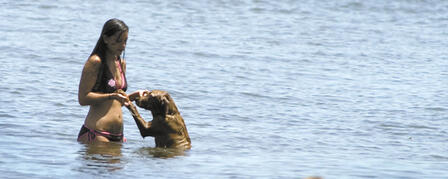KEEP PETS, PEOPLE AWAY FROM BLUE-GREEN ALGAE

August 25
Lake users urged to heed KDHE advisories
PRATT — Throughout the summer of 2011, the Kansas Department of Health and Environment (KDHE) has been sampling recreational bodies of water for blue-green algae when they are alerted to a potential algae bloom. When problems arise, they cooperate with the Kansas Department of Wildlife, Parks and Tourism (KDWPT) and federal officials to inform the public. When blue-green algae warnings or advisories are issued, signs are posted throughout the affected areas, and local media are alerted.
KDHE has confirmed that toxic blue-green algae is responsible for the death of one dog and suspected death of two others. The two dogs suspected of blue-green algae poisoning are presently undergoing testing at the K-State Laboratory. In all three instances, the dogs had been in the water at Milford Reservoir, which is in Clay, Geary and Dickinson counties. Since May, when blue-green algae was first detected during the 2011 season, there have been 17 reported cases of human illness after exposure to blue-green algae. KDHE cannot confirm that these cases are a direct result of blue-green algae exposure because external factors, such as medical history, could be an underlying cause.
Based upon the latest sampling results and established health risk levels, KDHE is currently issuing warnings and advisories, and lake users should understand these two terms. Symptoms of exposure include vomiting, diarrhea, skin rashes, eye irritation, and respiratory symptoms, and it can be fatal to pets.
A “warning” is issued when high levels of toxic blue-green algae have been detected. A “Public Health Warning” indicates that water conditions are unsafe, and direct water contact (wading, skiing, and swimming) should be avoided. An “advisory is issued when harmful blue-green algae have been detected. A “Public Health Advisory” indicates that a hazardous “condition” exists, but water activities such as boating and fishing may be safe. However, direct contact with water (wading, swimming) is strongly discouraged for people and pets.
While blue-green algae blooms will fade with cooler fall weather, those who use Kansas waters for recreation should heed KDHE warnings and advisories. Enjoy the water, but be safe.
For more information, contact the nearest KDWPT office or visit the KDHE website, http://www.kdheks.gov/news/index.html.
-30-









